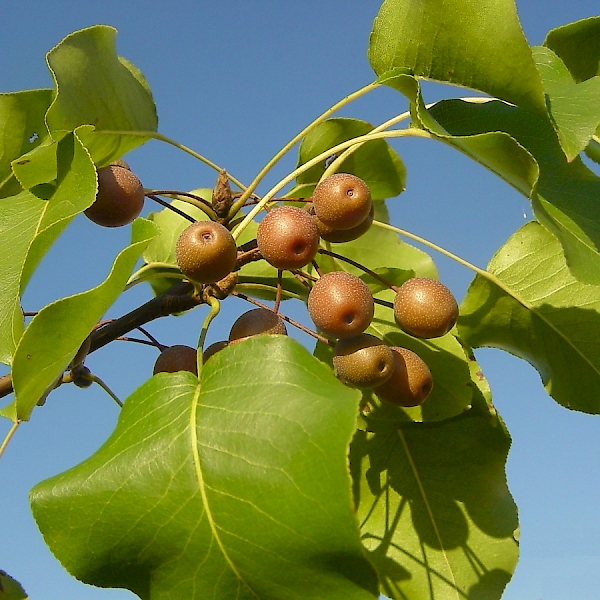
by Rick O'Connor | Jul 27, 2021
Six Rivers “Dirty Dozen” Invasive Species
Callery Pear – Bradford Pear (Pyrus calleryana)

Callery Pear
Photo: University of Florida IFAS
Define Invasive Species: must have all of the following –
- Is non-native to the area, in our case northwest Florida
- Introduced by humans, whether intentional or accidental
- Causing either an environmental or economic problem, possibly both
Define “Dirty Dozen” Species:
These are species that are well established within the CISMA and are considered, by members of the CISMA, to be one of the top 12 worst problems in our area.
Native Range:
Korea and China
Introduction:
The Callery Pear was introduced to the United States in the early 1900s intentionally as an ornamental plant. Its fruits were sterile because they do not self pollinate and spreading was not an issue. New cultivars were produced to reduce the tendency of the tree to split when covered with snow, or in high winds. The ‘Bradford’, and other cultivars, have hybridized with the Asian Pear (P. betulifolia) and produced fertile fruit that have spread into natural areas and become an ecological problem.
EDDMapS currently list 6,112 records of this plant spread across the United States. 1,837 are listed in the southeastern United States and 164 of those are in Florida. All 164 are found within the Six Rivers CISMA in Santa Rosa and Okaloosa counties. It is most likely under reported.
Description:
It is a tree that can reach 50 feet in height. It grows very quickly and the branches are close together forming a dense round-ish canopy. The leaves are glossy, simple, ovate in shape, serrated on the edges, and alternate on the branch. It is a deciduous and will turn all sorts of colors in the fall. It produces a beautiful white blossom tinged in pink. It does produce an aroma that some find unpleasant. The fruits are round, about 0.5-1.0” in diameter, and golden brown in color. The bark is dark to light brown in color and very smooth to the touch.
Issues and Impacts:
The primary issue with the Bradford cultivar is the ecological problems it has caused in natural areas. The University of Florida IFAS Assessment considers it a high risk as an invasive species.
Management:
Trees should be cut down and stumps treated with either glyphosate or triclopyr products. Multiple treatments will be needed.
For more information on this Dirty Dozen species, contact your local extension office.
References
Callery (Bradford) Pear. Invasive Plant Atlas of the United States. https://www.invasiveplantatlas.org/subject.html?sub=10957.
Early Detection and Distribution Mapping System (EDDMapS)
https://www.eddmaps.org/
Gilman, E.F., D.G. Watson, R.W. Klein, A.K. Koeser, D.R. Hilbert, D.C. McClean. Pyrus calleryana, “Bradford” Callery Pear. University of Florida Electronic Data Information System publication.
https://edis.ifas.ufl.edu/pdf/ST/ST53700.pdf.
Six Rivers CISMA
https://www.floridainvasives.org/sixrivers/
University of Florida IFAS Assessment
https://assessment.ifas.ufl.edu/assessments/pyrus-calleryana/
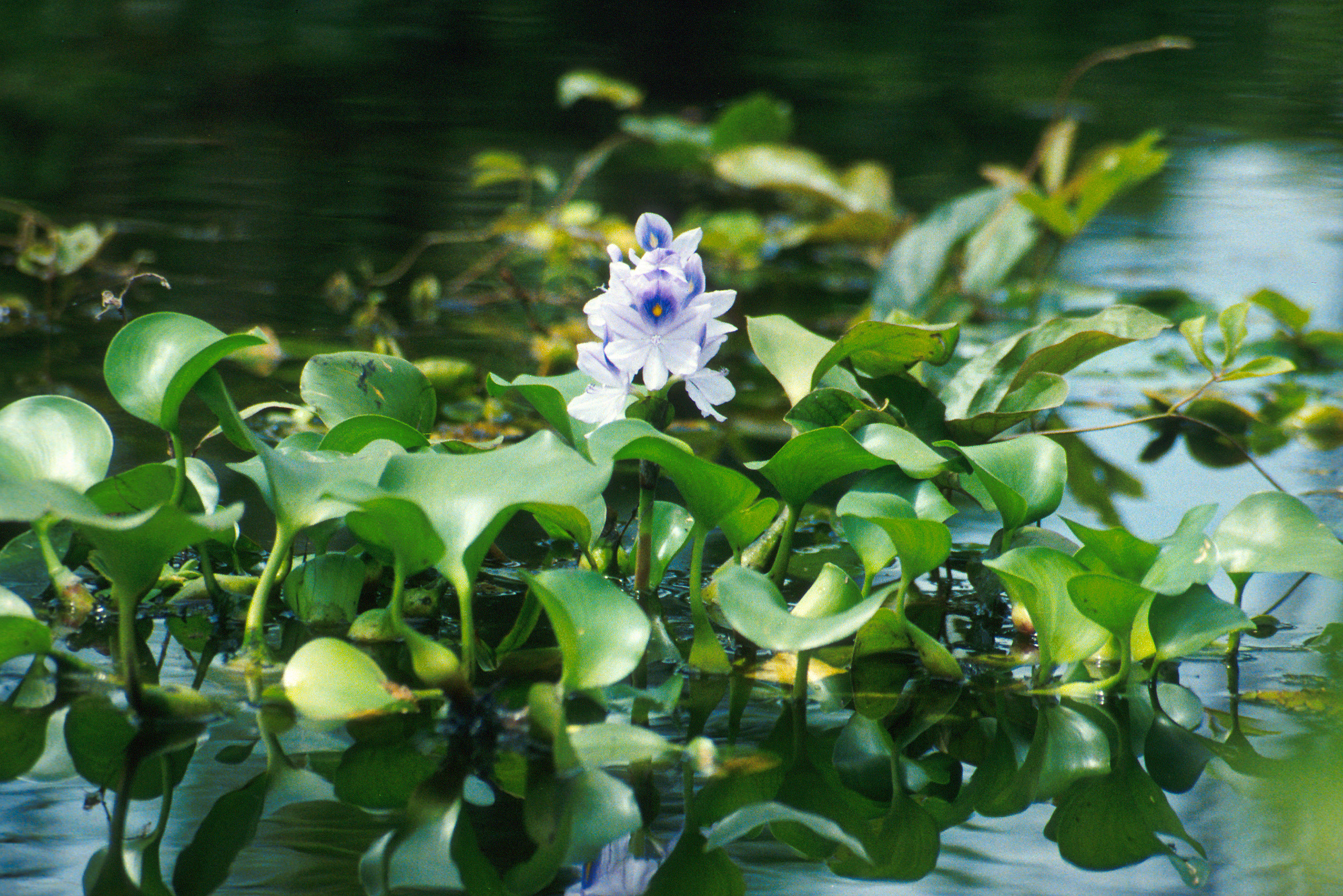
by Rick O'Connor | Jul 22, 2021
EDRR Invasive Species
Water Hyacinth (Eichhornia crassipes)
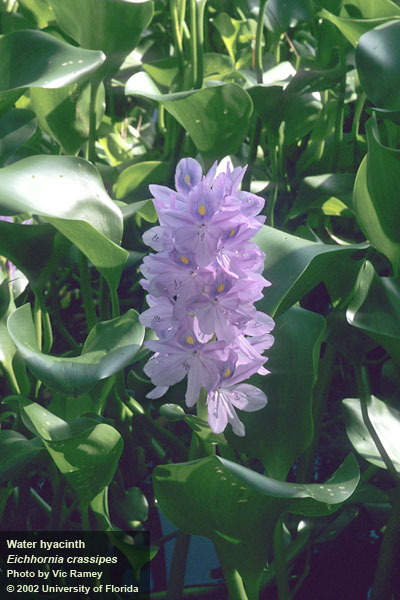
Water Hyacinth Photo Credit: Vic Ramey, UF/IFAS
Define Invasive Species: must have ALL of the following –
- Is non-native to the area, in our case northwest Florida
- Introduced by humans, whether intentional or accidental
- Causing either an environmental or economic problem, possibly both
Define EDRR Species: Early Detection Rapid Response. These are species that are either –
- Not currently in the area, in our case the Six Rivers CISMA, but a potential threat
- In the area but in small numbers and could be eradicated
Native Range:
Water hyacinth is native to South America.
Introduction:
It was introduced intentionally by horticulturists in 1884 at the Cotton States Exposition in New Orleans.
EDDMapS currently list 15,051 records of water hyacinth in the U.S. These records are scattered across the country with over 12,000 coming from the state of California. There are 1,229 reported from the southeastern U.S., which is certainly under reported, and 784 in Florida, also under reported – though resource managers indicate that amount of water hyacinth in Florida has decreased with management efforts. There are 13 records reported from the Six Rivers CISMA. This is assumed to be under reported but suggest the plant is correctly listed as an EDRR species and spread could be stopped. Three are from the Mobile delta area, one from Fairhope AL, and the remaining in Okaloosa County.
Description:
This is a perennial free floating freshwater aquatic plant, with long dark roots. The leaves form rosettes and the petioles can be 12” in length. They are bulbous and inflated, particularly near the base. The leaves are a deep green and glossy looking. They can be six inches wide and elliptic in shape.
The flowers extend above the rosette. They are lavender and blue with a flash of yellow. The flower can be 12” tall and 2” across.
Issues and Impacts:
The plant can form extremely dense floating mats making boating, fishing, or any other water recreation impossible. These dense mats can inhibit the growth of other native plants, reducing certain aquatic animals, and overall decreasing biodiversity. The mats reduce air-water oxygen exchange reducing dissolved oxygen as well as block sunlight reducing the development of many submerged aquatic vegetation. Again, reducing the systems overall biodiversity.
Management:
Small patches in local ponds and lakes can easily be removed by hand.
For large infestations there are large mechanical mowers/choppers that can be used to remove from the waterway. The remains can be further chopped and disposed of.
There are herbicides that can be used but these must be ones approved by both the U.S. EPA and FDACS for use in aquatic systems. The labels will state this. It is illegal to do so otherwise. Care should be taken when selecting herbicides for aquatic use considering other important aquatic plants and toxicity to aquatic animals such as fish. Diquat is considered an excellent choice. Carfentrazone and copper are considered fair. Others are not recommended. NOTE: these herbicides do not always completely eradicate the plant and windy conditions can make treatments a problem. The EDIS publication referenced below is a helpful resource to begin review of chemical treatment, and you can always contact your county extension office for more advice before using aquatic herbicides.
For more information on this EDRR species, contact your local extension office.
References
Water Hyacinth, Eichhornia crassipes
University of Florida IFAS Center for Aquatic and Invasive Plants
https://plants.ifas.ufl.edu/plant-directory/eichhornia-crassipes/
Efficacy of Herbicide Active Ingredients Against Aquatic Weeds.
Enloe, S.F., M.D. Netherland, W. Haller, and K. Langeland.
University of Florida IFAS Electronic Data Information Service (EDIS)
https://edis.ifas.ufl.edu/publication/ag262.
Early Detection and Distribution Mapping System (EDDMapS)
https://www.eddmaps.org/
Six Rivers CISMA
https://www.floridainvasives.org/sixrivers/
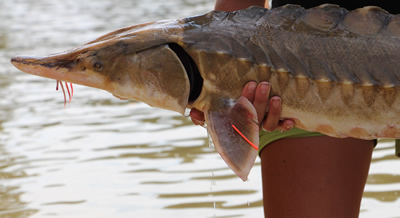
by Rick O'Connor | Jul 9, 2021
This is one strange, primitive, dinosaur-looking fish. They have large scutes embedded in their skin that give them an armored look. They are big – reaching 14 feet in length and 800 pounds (though the Gulf sturgeon does not reach the large size of their cousin the Atlantic sturgeon). They resemble sharks with their heterocercal caudal fin and possess long whiskers (barbels) suggesting a benthic mode of feeding.
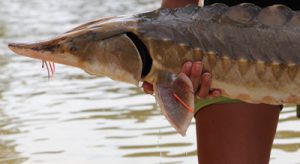
Sturgeon are large fish. The barbels (whiskers) are for finding prey buried in the sediment. Notice the raised ganoid scales of this ancient creature.
Photo: U.S. Fish and Wildlife Service.
Panhandle residents know them from their impressive leaps as they head upriver for spawning in the spring. The loud splash from one of these leaps can be heard for a long distance and is a concern for boaters who may be zipping up and down one of the local rivers on a jet sky, or even a bass boat. When in college, we asked one of the professors – “why do mullet jump?”. He paused for a second and responded – “for the same reason manta rays jump”. There was another longer pause. Understanding what was going on we took the bait and asked – “okay… why do manta rays jump?” – “we don’t know”. However, that was in 1980 and a lot has been learned since. We know that not only do mullet and mantas leap, but baleen whales and sturgeon do as well. It is believed that baleen whales leap to communicate during the breeding season. Since sturgeon breed in panhandle rivers, it is believed that this is the reason they may do so. Scientists have also found it helps adjust their swim bladders with internal gas making them more buoyant in the water.
Like salmon, sturgeon swim up rivers to breed and spawn in the spring. Fertilization is external and the gray-black eggs are laid on the substrate at the bottom. The newborn and adults spend the remaining spring in the rivers, and the adults do not feed at this time. In summer all head for the estuaries where the adults begin feeding with a vengeance. They feed on a variety of benthic invertebrates and prefer sections of the bay that are well oxygenated. Sturgeon spend the summer and much of the fall in the bays until the temperatures begins to drop at which time they head into the open Gulf of Mexico. The spring, they find their breeding rivers and the reproductive cycle begins again. This is a long-lived fish, reaching up to 50 years in age.
As far as the biogeography of this species, it is an interesting one. They have been around for about 200 million years. This was about the time the whole “Pangea” movement was going on – Florida did not look like Florida then. There was an opening between what is now the southeastern United States and the Florida peninsula. The water moving through this was called the Georgia Seaway or the Suwannee Channel. This allowed marine species to easily move from the Atlantic to the Gulf of Mexico. It was believed the current in this seaway was significant enough to keep silt and clays from reaching what would be become peninsula Florida, which was probably a submerged region of islands at the time.
During those times the Atlantic sturgeon (Acipenser oxyrinchus) inhabited this region, using southeast rivers for breeding. About 25 million years ago global land mass changes began a period of ice formation that encouraged sea level to drop and the peninsula portion of Florida was exposed – the Florida people know today. However, this new peninsula isolated populations of sturgeon (and other fish at that time) from reaching each other. As time moved on, different genetic changes occurred in both populations to produce offspring that varied from each other. These external morphological changes were enough to let you know they were different, but genetically they are close enough to still breed. In these situations, they have deemed “subspecies” of each other. The Atlantic sturgeon (Acipenser oxyrinchus oxyrinchus) and the Gulf sturgeon (Acipenser oxyrinchus desotoi). It is the Gulf sturgeon we find along the panhandle. This process of producing new subspecies and species due to population isolation over time is called speciation.
Another interesting trend is the original range of the Gulf sturgeon was from the Texas/Louisiana border to about Tampa Bay. This suggest that the fish took advantage of numerous rivers for breeding but there was a barrier as you reach the tropics. Whether that barrier was climatic (temperature) biological (food source) or something else I am not sure. With the high concentration of sturgeon in the panhandle you might think they require the alluvial rivers of this region. But sturgeon are as common in tannic rivers, such as the Suwannee and Yellow Rivers, as they are in those alluvial ones, such as the Escambia and Apalachicola.
Today, their range is even smaller. They are now found only in the rivers between Louisiana/Mississippi border to the Suwannee River. This range reduction is probably due to habitat alteration (much of it human induced – such as dams) and overharvesting (the eggs of the sturgeon are used for caviar). Today all species and subspecies of sturgeon are protected by the endangered species act.
Because this is an ancient fish, the biogeographic story of the sturgeon is an interesting one and shows how speciation occurs over time with all life. They are really cool fish and, if you have not seen one leap yet, I hope you get to. It is pretty amazing.
References
Florida’s Geologic History, University of Florida IFAS, https://edis.ifas.ufl.edu/publication/UW208.
NOAA Species Directory, Gulf Sturgeon, https://www.fisheries.noaa.gov/species/gulf-sturgeon.
NOAA Species Directory, Atlantic Sturgeon, https://www.fisheries.noaa.gov/species/atlantic-sturgeon.
Sturgeon, Florida Fish and Wildlife Conservation Commission, https://myfwc.com/conservation/you-conserve/wildlife/sturgeon/#:~:text=When%20the%20ambient%20pressure%20changes,to%20communicate%20with%20other%20sturgeon..
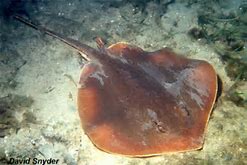
by Rick O'Connor | Jun 18, 2021
In our continuing series on the biogeographic distribution of island vertebrates, this week we look at a creature that, for some, is as scary as sharks – the rays. The term stingray conjures up stinging barbs and painful encounters, and these have happened, but rays are easily scared away by our activity. Occasionally people will step on one and the venomous spine is used to make you move your foot. You can avoid this by shuffling your feet when moving across the sand. Rays detect the pressure and move before you reach them. Again, negative encounters with rays are not common.

The Atlantic Stingray is one of the common members of the ray group who does possess a venomous spine.
Photo: Florida Museum of Natural History
There are 18 species of rays (from 9 families) found in our area. An interesting note, only eight of those possess a barb for stinging, and five are from the family Dasyatidae (the stingrays). Others that have barbs include the butterfly ray, cownose ray, and the eagle ray.
Rays are related to sharks but differ in that (a) the pectoral fin begins before the gills slits, and (b) the gill slits are on the underneath of the body – not on the side as found in sharks. Shark distribution seems to be controlled by water temperature. We see this with ray distribution as well, but interestingly the skates seem to be restricted to the Gulf of Mexico. Some are found almost exclusively in the east or west side of the Gulf.
Skates resemble stingrays but lack the venomous barb. They will usually have small thorns on their bodies and lay their developing embryos in a leathery egg case folks call “mermaid’s purse” when they wash ashore. There are four species found in the Gulf, but the spreadfin skate is ONLY found in the Gulf of Mexico and is not found along the Florida peninsula. The clearnose skate, which can be found all along Florida and the eastern seaboard of the U.S., is absent from western Gulf. It is interesting to try and understand why. What barrier keeps these two skates from colonizing the entire Gulf?
There is a large plume of muddy freshwater that expands from the Mississippi River into the Gulf off Louisiana. This plume could be a barrier for coastal species trying to expand their range. However, the spreadfin skate is reported to be an outer continental shelf species and may not be influenced by this lower salinity water. So, what is their story?
And why are these not found in the Caribbean? In the Caribbean you do enter tropical waters where coral reefs become more common. There is certainly a species shift when you reach this zone and it could be the food needed by these skates is not found here – a biological barrier. Many find these biogeographic situations interesting.
There are 12 species that have the typical “Carolina marine fish” distribution, which means they are found throughout the Gulf up the eastern seaboard to Massachusetts and south to Brazil. Two, the Atlantic torpedo ray and the roughtail stingray, expand their range farther into Canada. As a matter of fact, the roughtail stingray prefers colder waters.
Torpedo rays are an interesting group. This family of fish includes two species here in the Gulf, the Atlantic torpedo ray and the lesser electric ray. Yep… these two have special muscle cells that can deliver an electric shock. It is believed this electric current can detect and stun prey as well as repel predators. The voltage is not dangerous but will get your attention.
Three of those “Carolina marine species,” the guitarfish, the lesser electric ray, and the yellow stingray, do not reach Massachusetts. Their distribution ends at North Carolina. You would have to guess water temperature as a barrier here. The warm Gulf stream begins heading east across the Atlantic Ocean off Cape Hatteras towards Europe. They could follow this current to Bermuda, but they have not been reported there. This could be due to depth (pressure), being benthic fish, or food barriers.
There is one family that is tropical, the sawfish. These bizarre dinosaur looking creatures were once common in the estuaries of the Gulf region. They are now rare and protected.
One species of stingray, the Atlantic stingray has been found in the lower reaches of Louisiana rivers. Like bull sharks, salinity may not be a barrier for them.
And then we have our “world travelers”. The manta and eagle rays are found across the globe in tropical waters, and eagle rays are common in temperate parts of the world.
The distribution of our rays is not as universal as sharks. The skates in particular have an interesting distribution pattern. Pensacola lies right at the boundary of the eastern and western Gulf of Mexico, so we find both geographic groups here. Though they may scare many people, rays are fascinating creatures and cool to see.
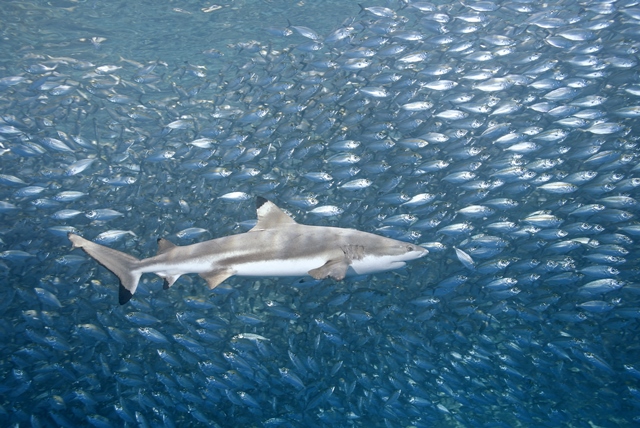
by Rick O'Connor | Jun 3, 2021
With this article we are going to begin a short series on the biogeography of panhandle vertebrates. Biogeography is the study of distribution of life and why species are found where they are. Many are interested in what species are found in a specific location, such as which sharks are found in our area, but understanding why others are not is as interesting.
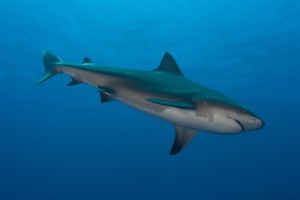
The Bull Shark is considered one of the more dangerous sharks in the Gulf. This fish can enter freshwater but rarely swims far upstream. Photo: Florida Sea Grant
All species have a point of origin and from there they disperse across the landscape, or ocean, until they reach a barrier that stops that dispersal. These barriers can be something physical, like a mountain range, something climatic, like the average temperature, or something biological, like to abundance of a specific food or predator. There are a lot of barriers that impede dispersal and explain why some species are not present in some locations.
Sharks are marine fish. In general, there is little to impede the dispersal of marine fish. All oceans are connected and there is no reason why a shark found in the Gulf of Mexico could not swim to Australia, and some have. But there are barriers that keep some species of south Florida fish from reaching north Florida – mean water temperature being one.
There are 24 species of sharks from nine different families found in the Gulf of Mexico. Most have a wide distribution range, and some are found worldwide. Nurse sharks are more tropical, common in the Keys, but are found in our area of the northern Gulf of Mexico. They are fans of structure and are often found near our artificial reefs.
Whale sharks and hammerheads are circumtropical, meaning they are restricted by water temperature but found worldwide in warmer waters. Whale sharks are the largest of all fish, reaching a mean length of 45 feet, and are not common near shore. They are plankton feeders and, though large, are harmless to humans. There are five species of hammerheads found in the Gulf of Mexico. They are easily identified by their “hammer” shaped head and are known for their large dorsal fin that, at times, will extend above the surface while they are swimming. Finding species of hammerhead inside the bay is not uncommon.
Several of our local sharks are not as restricted by water temperature and are found as far north as Canada. Sand tigers, threshers, and dogfish seem to prefer the cooler waters and, though found in the Gulf, are not common. There are two members of the mackerel shark family found here. Great whites, of movie fame, prefer cooler waters and are found worldwide – except for polar waters. There are records in the Gulf, but most are offshore in cooler waters. As you know, these are large predatory sharks, reaching up to 25 feet in length, and are known to feed on large prey such as seals. Their cousin the shortfin mako, prefers warmer waters and is more common here. Nearshore encounters with makos is rare but has happened.
The largest family, and best known, are the requiem sharks. There are 13 species in the Gulf, and many are common in our area. Many are not as restricted by water temperature and can be found as far north as New York. Bull sharks are not restricted by salinity and have been found up rivers in Alabama, and Louisiana. Silky sharks are more tropical, and the tiger and spinner sharks are more circumtropical.
The geographic distribution of sharks seems centered on water temperature. Most can easily swim the oceans to locations across the globe but congregate in areas of preferred temperatures and food. Though feared because of attacks on humans, a rare thing actually, they are fascinating animals and world travelers.








